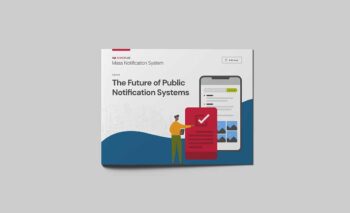The Dangers of Communication Delays in Emergency Situations
In times of crisis, every second counts. Whether it’s a natural disaster, a public health emergency, or a critical infrastructure failure, public communicators must have the ability to widely disseminate accurate information — and fast.
Communication delays in emergency situations aren’t just inconvenient; they can be dangerous, leading to confusion, panic, and even loss of life. If wildfires are approaching, a tornado is spotted on the radar, or a chemical spill is threatening the local water supply, residents need to know what’s going on as quickly as possible. Delays leave everyone vulnerable.
Why Emergency Communication Must Be Fast and Efficient
Residents want to know what’s going on in their community, but unfortunately, most people feel out of the loop. A CivicPlus® survey found that just 41% of residents are satisfied with how their local government shares information, while a staggering 78% say they support tax dollars being spent on software that can help improve communication.
That’s because information delays can lead to a number of issues, including:
- Increased Risk of Injury and Fatality: The most obvious danger is the direct threat to human life. Without timely warnings, residents may find themselves in the path of danger without any chance to properly prepare or react. Evacuation routes may become blocked, shelters may fill up, and individuals may be caught off guard, significantly increasing the risk of injury or death.
- Widespread Panic and Misinformation: In the absence of clear and prompt communication, rumors and misinformation can quickly spread. While social media is a powerful communication tool, it can also become a breeding ground for speculation and fear-mongering. This can misdirect emergency response efforts and cause mass panic that leads residents to make poor decisions based on inaccurate information, further compounding the crisis.
- Hindered Emergency Response: Communication delays can also hamper the efforts of emergency personnel, leading to a delayed or misdirected response. This can waste valuable time and resources, potentially exacerbating the impact of the emergency.
- Economic Losses: Beyond the immediate threat to life and safety, communication delays can also have significant economic consequences. Businesses may be forced to close, transportation systems may be disrupted, and critical infrastructure may be damaged. The longer the delay in communicating the situation and coordinating a response, the greater the potential for economic fallout.
- Erosion of Public Trust: Slow, unclear, or inconsistent communication can erode public trust. This can lead to resentment or apathy, and make future emergency response efforts even more challenging.
Read More: The Role of Local Government in Emergency Response and Routine Communications
How to Mitigate the Dangers of Communication Delays
Strategic planning can help your agency deliver fast, efficient communication, especially during emergencies.
To ensure a timely response when disaster strikes, government leaders must:
- Invest in Robust Communication Systems: Local governments and organizations need to invest in reliable communication systems that can reach a wide audience through multiple channels. This includes mass notification systems, social media monitoring tools, and partnerships with local media outlets.
- Develop Comprehensive Communication Plans: Having a well-defined communication plan in place is crucial. This should outline clear protocols for disseminating information during emergencies, including specific roles within a department, what information needs to be shared in various scenarios, and how it will be delivered.
- Regularly Test and Train: Communication systems and plans should be regularly tested and updated to ensure they are functioning effectively. Emergency responders and community members should also be trained on how to use these systems and what to do in the event of an emergency.
- Embrace Technology: Leveraging technology can significantly improve the speed and reach of emergency communications. Mobile apps, social media platforms, and other digital tools can help improve efficiency.
- Foster Collaboration: Effective communication requires collaboration between government agencies, emergency responders, community organizations, and the public. Establishing strong relationships and clear lines of communication before an emergency occurs is essential.
Read More: How To Guard Against Sending Out False Emergency Mass Notifications
Ways to Build a Safer, More Connected Community
Timely communication is a cornerstone of effective emergency management. By recognizing the dangers of communication delays and investing in robust communication systems and plans, communities can better protect themselves and minimize the impact of disasters.
The CivicPlus Mass Notification system was built with decades of local government expertise to support thriving, resilient communities. Not only is the system a reliable, user-friendly method for sending accessible, multi-channel alerts, but also, it integrates seamlessly with other software to streamline processes.
Learn more about how our robust Mass Notification system can help your department boost resident engagement, satisfaction, and public safety.


